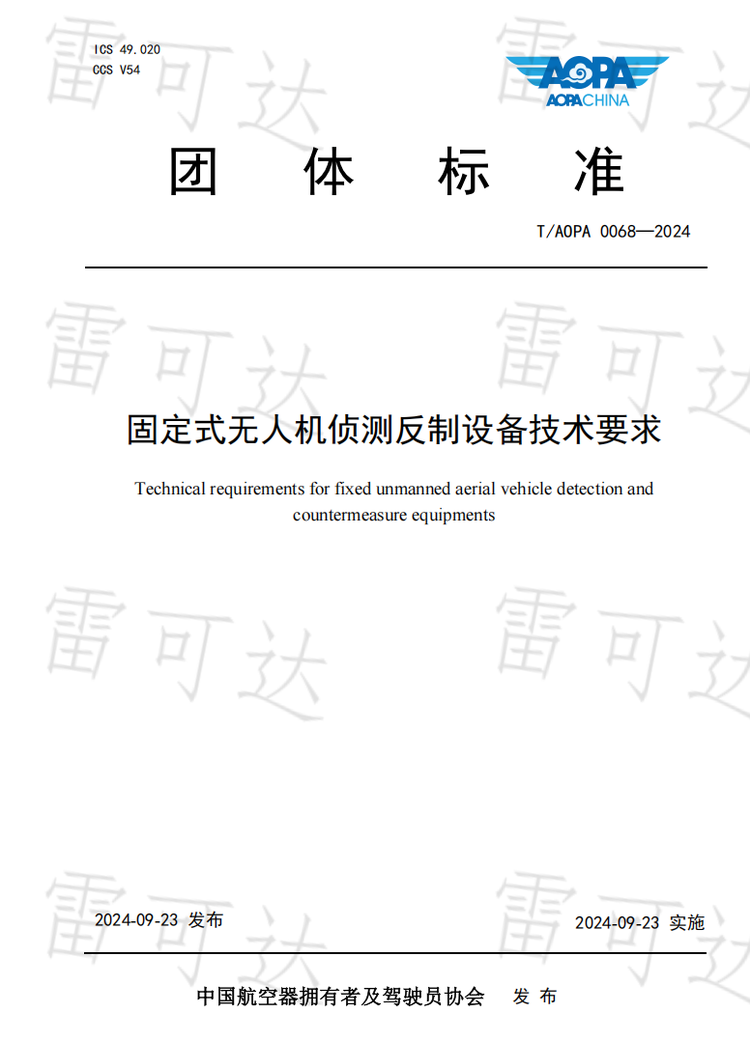
Technical Specifications and Requirements for Fixed Drone Detection and Countermeasure Equipment
1 Scope of Application
This document specifies the core functions, performance indicators, and technical requirements for fixed drone detection and countermeasure equipment. It applies to fixed detection and countermeasure systems targeting micro, light, and small drones, providing a technical basis for the development, production, and deployment of such equipment.
2 Normative References
The following documents, through reference in this standard, constitute provisions of this document. For dated references, only the edition cited applies. For undated references, the latest edition (including any amendments) applies.
- T/SZUIA 001—2021 “General Requirements for Low, Slow, and Small Drone Detection and Countermeasure Systems”
3 Terms and Definitions
3.1 Drone Detection and Countermeasure Equipment
Refers to integrated system equipment designed to defend against aerial drone threats, capable of detection, tracking, positioning, and countermeasure intervention.
3.2 Fixed Drone Detection and Countermeasure Equipment
Refers to professionally deployed equipment installed in a fixed manner to perform drone detection, identification, and countermeasure tasks.
3.3 Networked Positioning
Supports autonomous networking of multiple devices to achieve precise positioning and coordinated countermeasures against drones over a wide area.
3.4 Detection
Utilizes technologies such as radar, spectrum analysis, and electro-optics to detect and transmit real-time information on drone direction, position, speed, trajectory, and image/video data.
3.5 Identification
Accurately determines multidimensional information, including the serial number, model, position, and operator location of drones within the detection range.
3.6 Countermeasure
Renders drones inoperable by interfering with specific frequency bands, disrupting control links, or jamming GNSS signals.
4 General Technical Requirements
4.1 General Requirements
The equipment must include components such as detection modules, countermeasure modules, control consoles, and servers, and must meet the following characteristics:
- Broadband detection capability covering mainstream drone frequency bands
- Adaptability to complex electromagnetic environments and harsh climatic conditions, enabling all-weather, omnidirectional protection
- High real-time detection and rapid response capabilities
- Support for directional and omnidirectional interference modes
- Capable of independent operation or multi-station networked expansion
- Flexible deployment suitable for various urban complex scenarios, including fixed, temporary, and vehicle-mounted setups
- High practicality, supporting standalone operation or multi-device collaborative precise positioning
- Compliance with frequency and transmission power limits specified in T/SZUIA 001-2021
4.2 Functional Requirements
The equipment must possess at least the following core functions:
- Detection Function: Supports multi-target detection, identification, early warning, and direction finding
- Countermeasure Function: Capable of repelling and forced landing, using physical or electronic interference techniques to disrupt drone operations without affecting normal civil aviation flights
4.3 Performance Indicator Requirements
- Operating Frequency Bands: Covers common frequency bands such as 433MHz, 900MHz, 1.1GHz, 1.2GHz, 1.4GHz, 1.5GHz, 2.4GHz, and 5.8GHz
- Response Speed: Intervention time < 10 seconds
- Detection Radius: Effective range > 500 meters
- Countermeasure Range: Effective operating distance > 500 meters
- Coverage Angle: Azimuth 0°–360°, elevation > 30°
- Multi-Target Capability: Supports simultaneous detection of multiple drones
- Positioning Accuracy: < 10 meters
- Operating Temperature: -25°C to 50°C
- Protection Rating: Clearly marked waterproof and wind-resistant levels
- Secondary Interference Control: Must consider the impact on the surrounding environment
- Transmission Power: Reasonably set based on environmental and navigation signal interference conditions
5 Detection Technical Specifications
5.1 General Requirements
Utilizes one or more technologies such as radar, radio monitoring, electro-optical identification, and acoustic monitoring to achieve drone detection, tracking, identification, and early warning, with precise display of target information.
5.2 Radar Detection
Achieves drone detection and positioning through electromagnetic wave reflection principles, complying with T/SZUIA 001—2021 safety distance and radiation protection regulations.
5.3 Radio Signal Monitoring
Supports scanning of at least one or more types of drone radio communication, GPS, Wi-Fi, Bluetooth, or other signal activities.
5.4 Electro-Optical Identification and Tracking
Combines visible light and infrared technologies to achieve automatic target identification and video forensics, supporting laser ranging and image stitching techniques.
5.5 Acoustic Monitoring
Achieves drone discovery and model identification through acoustic signature analysis, ensuring the completeness of the acoustic signature database.
6 Countermeasure Technical Specifications
6.1 General Requirements
Selects physical or electronic countermeasure technologies based on application scenarios to ensure the success rate of repelling or forced landing meets safety requirements.
6.2 Physical Means
- Direct Destruction: Employs precise strike methods such as missiles, lasers, or microwaves
- Interception and Capture: Achieves interception through means such as capture nets or combat drones, with consideration for fall safety
6.3 Electronic Means
- Control Signal Spoofing: Decodes communication protocols to send false control commands
- Navigation Signal Spoofing: Controls flight paths through techniques such as no-fly zone spoofing or return point spoofing
- Hacking Techniques: Gains control access through terminal intrusion, with attention to the impact of authority alternation
This document is prepared in accordance with the T/AOPA 0068-2024 standard, providing comprehensive technical specifications and guidance for fixed drone countermeasure systems.
Related Readings
- “Technical Requirements for Civil Drone Detection and Countermeasure Systems” (T/SZUIA 001—2021) - Full text and interpretation of the Shenzhen UAV Industry Association standard
- AOPA Drone Industry Standard System - Official standard release platform of the Aircraft Owners and Pilots Association of China
- MIIT “Technical Guidelines for UAV Radio Interference Prevention and Control (Trial)” - Official document from the Radio Administration Bureau of the Ministry of Industry and Information Technology (updated 2023)